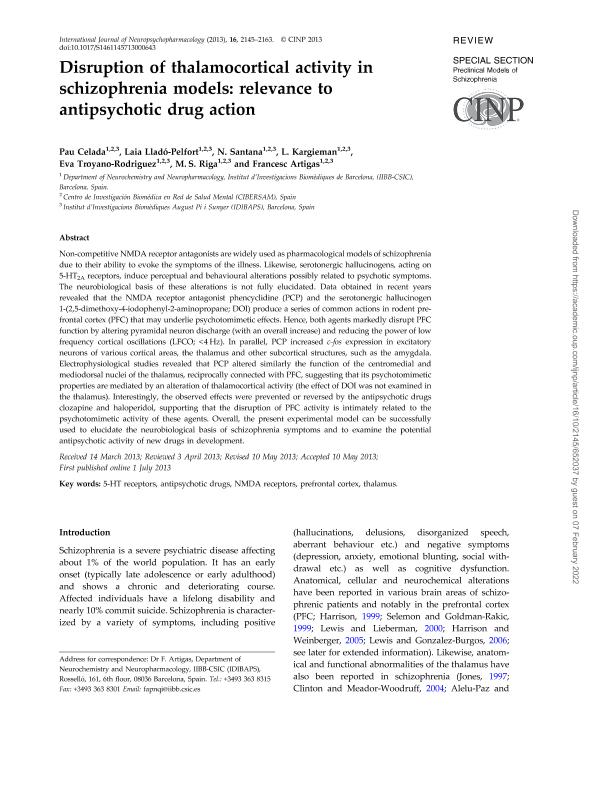Artículo
Disruption of thalamocortical activity in schizophrenia models: relevance to antipsychotic drug action
Celada, Pau; Lladó Pelfort, L.; Santana, N.; Kargieman, Lucila ; Troyano Rodriguez, Eva; Riga, M. S.; Artigas, Francesc
; Troyano Rodriguez, Eva; Riga, M. S.; Artigas, Francesc
 ; Troyano Rodriguez, Eva; Riga, M. S.; Artigas, Francesc
; Troyano Rodriguez, Eva; Riga, M. S.; Artigas, Francesc
Fecha de publicación:
11/2013
Editorial:
Cambridge University Press
Revista:
International Journal Of Neuropsychopharmacology
ISSN:
1461-1457
Idioma:
Inglés
Tipo de recurso:
Artículo publicado
Clasificación temática:
Resumen
Non-competitive NMDA receptor antagonists are widely used as pharmacological models of schizophrenia due to their ability to evoke the symptoms of the illness. Likewise, serotonergic hallucinogens, acting on 5-HT2A receptors, induce perceptual and behavioural alterations possibly related to psychotic symptoms. The neurobiological basis of these alterations is not fully elucidated. Data obtained in recent years revealed that the NMDA receptor antagonist phencyclidine (PCP) and the serotonergic hallucinogen 1-(2,5-dimethoxy-4-iodophenyl-2-aminopropane; DOI) produce a series of common actions in rodent prefrontal cortex (PFC) that may underlie psychotomimetic effects. Hence, both agents markedly disrupt PFC function by altering pyramidal neuron discharge (with an overall increase) and reducing the power of low frequency cortical oscillations (LFCO; < 4 Hz). In parallel, PCP increased c-fos expression in excitatory neurons of various cortical areas, the thalamus and other subcortical structures, such as the amygdala. Electrophysiological studies revealed that PCP altered similarly the function of the centromedial and mediodorsal nuclei of the thalamus, reciprocally connected with PFC, suggesting that its psychotomimetic properties are mediated by an alteration of thalamocortical activity (the effect of DOI was not examined in the thalamus). Interestingly, the observed effects were prevented or reversed by the antipsychotic drugs clozapine and haloperidol, supporting that the disruption of PFC activity is intimately related to the psychotomimetic activity of these agents. Overall, the present experimental model can be successfully used to elucidate the neurobiological basis of schizophrenia symptoms and to examine the potential antipsychotic activity of new drugs in development.
Palabras clave:
5-Ht Receptors
,
Antipsychotic Drugs
,
Nmda Receptors
,
Prefrontal Cortex
,
Thalamus
Archivos asociados
Licencia
Identificadores
Colecciones
Articulos(SEDE CENTRAL)
Articulos de SEDE CENTRAL
Articulos de SEDE CENTRAL
Citación
Celada, Pau; Lladó Pelfort, L.; Santana, N.; Kargieman, Lucila; Troyano Rodriguez, Eva; et al.; Disruption of thalamocortical activity in schizophrenia models: relevance to antipsychotic drug action; Cambridge University Press; International Journal Of Neuropsychopharmacology; 16; 10; 11-2013; 2145-2163
Compartir
Altmétricas



